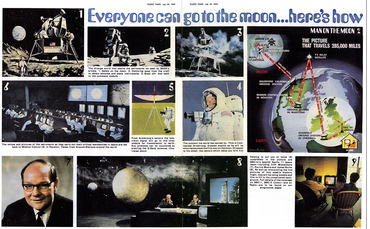The 6-12 July issue carried an eight-page centre section that was an exact facsimile of the 50-year-old 12-18 July 1969 section. This explained how the spaceships worked, who would crew them, and other details of the mission and its background.
It also looked at how the BBC would cover the events, with a team fronted by news veteran Cliff Michelmore, astronomer Patrick Moore from The Sky at Night and science reporter James Burke from Tomorrow’s World. It finished with a news panel on a brand new science fiction space show from the USA, called Star Trek.
In those days the Radio Times was mostly black and white, with colour covers and the odd colour centre section still a novelty. Printing was handled by Waterlows at its Park Royal and East Kilbride plants, although colour supplements – which had to be printed six weeks in advance – were gravure printed by Purnell in Paulton.
What’s remarkable 50 years on is how good the reprint is. There’s no moiré, the text and line work is sharp, the colours are bright and the background isn’t yellow (see image below). Compared to an original 1969 from your correspondent’s scrapbook, it looks totally clean and original. As anyone knows who’s tried to reprint old colour print, that’s not easy.

So how was it done?
We asked Koli Pickersgill, production and repro director at Radio Times publisher Immediate Media in London. The project was handled by art editor Jacob Howard and senior pre-media controller Robert James.
“The objective was to give the reader the very best visual experience and have a contemporary feel about the feature,” says Pickersgill. “Several reprographic steps were taken. Each page of the original Radio Times moon edition was scanned separately. At the scanning stage, a de-screening tool was used to try and avoid the moiré.
“Three parts of the images were isolated into CMYK images and text headings, the yellow paper background and the black mono text. This was very tricky but imperative to do, to gain the best clarity and reproduction quality,” she explained.
“As a result, Robert was then able to reduce the paper colour down to white from the yellow origins and keep the CMYK images and text headings nice and strong. Black text was converted to a clear black for legibility. Jacob then coordinated the single pages to make spreads in his design for the finished piece.”
The printing was part of the normal web offset print run at Walstead Peterborough.
Author’s note: in 1969 your contributor Simon Eccles was a space-obsessed schoolboy. Like many others I made up a scrapbook of newspaper and magazine clippings covering the whole of 1969 in space, which actually saw four of the Apollo missions: 9, 10, 11 and 12. Apollo 11 in July was the first actual moon landing. The scrap book has clippings from the Radio Times, Sunday Times, Manchester Evening News, a Blue Peter Annual and the Gerry Anderson-themed weekly comic TV21.
When the Radio Times put its moon supplement reprint into the last issue, I remembered my scrapbook and dug it out. Sure enough, I had the whole of that original supplement carefully Sellotaped in place, and only a little yellowed after 50 years. Being able to do a direct comparison with the 2019 reprint, I was impressed by what a good job Immediate Media had done, with sharp text, bright and punchy colours and little to no moiré.
By comparison a reprint of colour print paragon National Geographic’s 1969 moon issue that’s in the shops now, is much more moiré-prone, though to be fair it has a lot more pages too.
As a note for print geeks of historical bent, the winding down of the space programme after Apollo led directly to some of our modern digital imaging technology. A lot of computer experts were looking for work, and some went into the nascent computer publishing companies, such as Atex.
Apollo 11 also took a very special TV camera to the moon, which beamed live coverage back to earth (so that ‘One small step for man’ was in real time, less transmission times). The camera used slow scan technology to work within the restricted radio bandwidth, giving a strange ghosting effect as the astronauts bounced around the lunar surface. More details here on Wikipedia.
The team at Westinghouse that built that camera included a young Efi Arazi, who later went on to found Scitex and EFI, two companies that helped to revolutionise digital colour pre-press and print in later decades. EFI is today a very big player, and while Scitex was split up, parts of it live on at HP and Kodak.
Towards the end of his career Arazi returned to his first love, video, and in my last interview with him in the late 1990s he was excitedly predicting a great future for high definition TV, long before anyone could buy it.
At the Ipex show in 1971 my father was working for Heidelberg, which at the time was agent for the BASF Nyloprint photopolymer plates for letterpress (flexo was years off). To show off the four-colour quality of these plates, Heidelberg printed some excellent large format posters with moon landing shots. I kept mine on my bedroom wall for years, but sadly they disappeared in a move. If anyone has one still, please get in touch!











